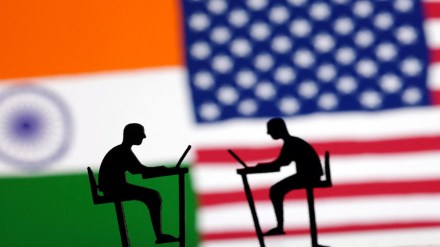By Anita Inder Singh
The stunning electoral triumph of an uncompromising, hard-hitting, domestically and internationally polarising Donald Trump in the American presidential election has caused global discomfort. America’s European friends fear that he may leave Ukraine and the rest of their continent open to Russia’s aggressive nationalism and impose high tariffs on their exports. China doesn’t want another Trumpian trade war. America’s Asian allies may need to dole out more cash in return for continued help to secure the Indo-Pacific against a territorially expansionist China.
Significantly, both Russia and a war-weary Ukraine anticipate that Trump might end their war sooner rather than later to the disadvantage of the other. Any softening of American and Western sanctions on Russia would be welcomed by Delhi which has dramatically increased trade linkages with Russia since it invaded Ukraine in February 2022. India is not nervous about a second Trump administration, given the cordial ties between him and Prime Minister Narendra Modi. But personal bonhomie will not suffice to strengthen Indo-US ties, given the transactionalism of both leaders and Trump’s insistence on “America First”.
Trump will undoubtedly exert pressure on India to lower what he has condemned as India’s excessive tariffs: let’s recall that it was Trump 1.0 that ended preferential trade status for India. At that time, Trump also voiced disapproval of India’s decision to buy Russia’s S-400 missile, declared that prosperous states made the best allies, and that economically rising Vietnam and the Association of Southeast Asian Nations were the heart of the Indo-Pacific.
A country’s economic wealth will carry weight with Trump 2.0 and India is unlikely to be his top Asian priority, despite its strong geostrategic position in the Indo-Pacific. Conflict and continuity will characterise India-US relations, which have become stronger since the signing of the civilian nuclear deal in 2006. This agreement reduced, though did not end, the often conflicting economic and strategic views of India and America, despite their shared interest in containing China. Trump 1.0 revived the Quad in 2017 and created the Indo-Pacific as a security entity, but the Indian and American visions of its geography diverged, despite their joint commitment to uphold the US-led rules-based order in the region.
China remains America’s top economic and military foe and Trump 2.0 will judge India by what Delhi offers in countering it.
In 2016, Trump 1.0 designated India as a “major defence partner” which strengthened their defence tie. But India has never come close to being an American ally, partly because it doesn’t want to, and partly because the US doesn’t want to take on a board one of Asia’s largest countries which has border conflicts with both its western neighbour, Pakistan and the eastern one, Pacific China, which has rapidly expanded its status and presence as an Indian Ocean power. China’s GDP per capita in 2015 was $8,016 — today it is just under $13,000. Comparable figures for India are $1,590 in 2015 and less than $2500 currently.
It is in India’s interest that Trump should try to contain China strategically in the South China Sea area. It threatens the territorial sovereignty of American allies including the Philippines and Japan, while claiming some of the turf of practically every Southeast Asian country. Add to that China’s claims to India’s northeastern territory, and the question of checkmating China will continue to be an important one for the Indo-US relationship. But Trump — like outgoing president Joe Biden — favours a bilateral solution to the Sino-Indian border dispute. Delhi should keep that in mind.
Job creation in the US and balancing trade will be strongly prioritised and may cause tension with India. For instance, Trump 2.0 will want to see more reciprocity in exchange for any technology transfers.
Both America and India have large international trade deficits. Modi’s “Make in India” was perceived as protectionist by Trump and conflicted with his manufacturing and export plans for America. That is why Trump 1.0 revoked India’s trade privileges. India imposed retaliatory duties on several American products. They failed to resolve their differences. And whether India will succeed in using the Initiative on Critical and Emerging Technologies with the intent of expanding technology transfers remains an open question.
Trump 1.0 wanted India to increase investment in Southeast Asia, but was he aware that Southeast Asian countries have stronger economic ties with China than with India? The diminution of India’s economic presence in the region, signified by its absence from the Regional Comprehensive Strategic Partnership (RCEP), will be noticed by Trump, not least because India’s absence from the world’s largest free trading bloc, inspired by its fear that the RCEP would be dominated by China, has actually strengthened China’s economic position in the Indo-Pacific — and India cannot counter it. Trump will certainly challenge Delhi on the fact that foreign investors are pulling out from India and returning to China.
At another level, India is facing opposition in the World Trade Organization from a mix of countries including America, Argentina, Australia, Canada, and Ukraine, which have alleged that India is providing significant market price support to wheat and rice. A watchful Beijing delivered an economic stimulus package to a slow-growing Chinese economy and will deliver another, $1.4 trillion one, in anticipation of new Trumpian tariffs on China. Indeed, even America’s European allies fear that Trump may launch a new tariff war which could cause global economic disruption.
A realistic India should anticipate a rocky — though not unfriendly — relationship with the second Trump administration.
The writer is founding professor, Centre for Peace and Conflict Resolution, New Delhi.
Disclaimer: Views expressed are personal and do not reflect the official position or policy of FinancialExpress.com. Reproducing this content without permission is prohibited.
